|
|
MaxillariaFamily: Orchidaceae.
| Maxillaria tenuifolia |
|
|
 |
The genus Maxillaria is represented by over 900 different species. They are spread throughout the new worrld ranging from northern Argentina through the West Indies and Central America up to Florida. Maxillaria plants are epiphytes, lithophytes or sometimes even terrestial. The vegetative plant forms are variable and can be subdivided into psuedobulbless and pseudobulbous plants. Pseudobulbs, always of a single internode, have 1-4 apical leaves, each with a prominent central vein. The influorescences are produced singly or in groups from either the axils of the rhizome sheaths, or from the base of the pseudobulbs. Each influorescence displays a single flower. Sepals and petals are subequal and free. Petals are similar to the sepals but smaller. The lip articulate simple or more or less 3-lobes. Lateral lobes, when present, are erect. The column is fleshy and also erect. There are always four waxy pollinia present. |
|
| Growing conditions |
Watering and misting |
Propagation |
| Cool- or intermediate growing orchids. Grow in epiphytic orchid potting mix in pots or slatted baskets, or epiphytically in slabs of bark. In summer, grow in moist partial shade. Admit full light in winter. |
Keep moist all year round. In summer, water freely amd mist once or twice daily. |
Divide when plants fill the containers and flow over the sides. |
|
Maxillaria arbuscula |
|
|
Little peppermint like flowers pop out throughout the year along the bracts. The large mother plant is in flower year around! These grow on the cool side with moderate light. |
 |
|
Maxillaria chrysantha |
|
|
A cute one that does well in baskets. Blooms at least twice a year. Grows on the cool side with moderate light. Plant divides easily, you can share with a friend. |
 |
|
Maxillaria elatior |
|
|
A very unusual maxillaria. Has vandaceous growth (no pseudobulbs) and the fragrant, bright yellow flowers with red lip pop out of the leaf axis thoughout the year. Can get to be quite tall (3'), but can be kept short. Grows best in intermediate conditions with moderate to bright light. |
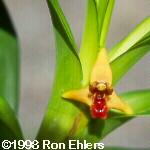 |
|
Maxillaria fractiflexa |
|
|
Best Species winner the the Greater New York Show in 1996. Single flowers are borne on tall spikes. Petals resemble a handlebar moustache. Easy to grow, likes it on the cool side of intermediate, and blooms at least twice a year. Flowers last three to five weeks. |
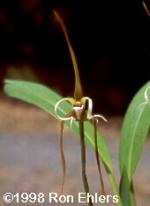 |
|
Maxillaria grandiflora 'Bob Hoffman' |
|
|
Magnificant white flower sits atop a long, sturdy stem. Flowers last for over six weeks and are highly fragrant. Easy grower and prefers intermediate to cool temperatures with moderate light. |
 |
|
Maxillaria lepidota |
|
|
Long, spidery, yellow flowers emerge from the base of the pseudobulbs. Grows easily to make a magnificent specimen. Prefers intermediate to cool temperatures with moderate light. |
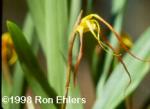 |
|
Maxillaria ochreleuca |
|
|
Spidery, white flowers cluster around center of plant. Grows easily. Prefers intermediate to cool temperatures with moderate light. Fragrant! |
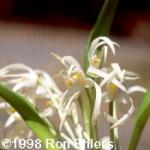 |
|
Maxillaria picta |
|
|
Epiphytic orchid with conical pseudobulbsand one narrowly oblong leaf, up to 12in (30 cm) long. Fragrant, deep yellow to white flowers, spotted purplr, dark red, or brown, up to 1.5in (4 cm) across, are borne on scapes 6in (15 cm) long, from spring to summer. Min. temperature 50F (10C), max. 86F (30C). |
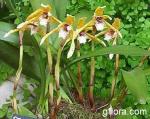 |
|
Maxillaria pseudoreichenheimiana |
|
|
Compact plant from Colombia. Derives its name from the mottled leaves that mimic the true M. reichenheimiana. Produces 8 - 20 flowers twice a year from the base of the pseudobulbs. Prefers intermediate temperatures with moderate light. |
 |
|
Maxillaria rhombea |
|
|
Medium size flowers emerge from the base of the plant and circle completely around the pot. The dark color ot this New World species is very eye-catching. Prefers the cooler side of intermediate with moderate light. |
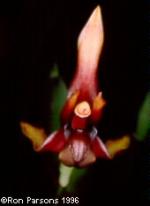 |
|
Maxillaria sanguinea |
|
|
Medium size flowers circle completely around the pot. Nice contrasting red/white flowers stand out among the foliage. Moderate to bright light with intermediate temperatures. |
 |
|
Maxillaria tenuifolia |
|
|
Red coconut-cream pie scented orchid from the Philippines. Flowers several times throughout the year. |
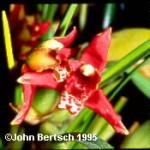 |
|
Maxillaria tenuifolia Lindl. |
|
|
Red coconut-cream pie scented orchid from Colombia & Ecuador. Flowers several times throughout the year. Vigorous grower and easy to divide. Flowers in April-May. |
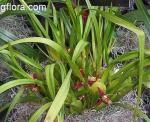 |
|
Maxillaria variabilis |
|
|
One of the smaller growing maxillarias. The two color forms, red (shown here) and yellow, are equally attractive. Grows on the cooler side of intermediate with moderate light. |
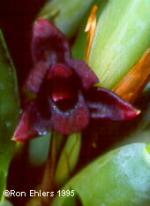 |
|
These materials are freely provided for instructional and educational purposes. Any duplication or publication of text or images herein for commercial gain without explicit written permission of the owner or photographer constitutes breach of trust and violation of copyright.
Copyright © Galka Okhapkina 1998-2025















